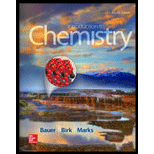
Concept explainers
Interpretation:
From the pictorial representation, the differences and similarities among the oxygen, magnesium oxide and carbon dioxide molecules are to be identified.
Concept Introduction:
From the figure, it is identified that the red ball corresponds to oxygen atoms, black ball corresponds to carbon atoms and golden ball corresponds to magnesium atoms.The magnesium oxide is identified as an ionic compound because it involves the combination of magnesium cation and oxide ion to form ionic bond, by the transfer of electrons between them whereas, carbon dioxide and oxygen are identified as molecular compounds because both oxygen and carbon are non-metals, which form a covalent bond by the sharing of electrons between them.
Want to see the full answer?
Check out a sample textbook solution
Chapter 3 Solutions
Introduction to Chemistry